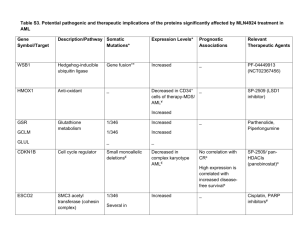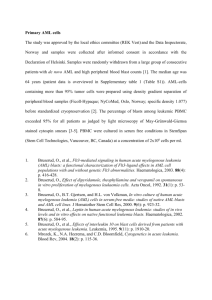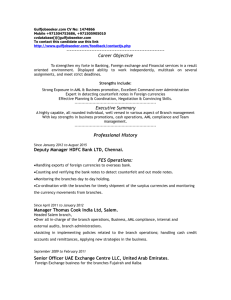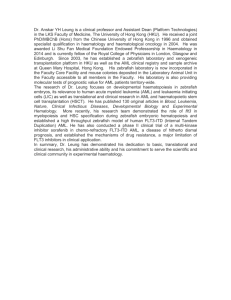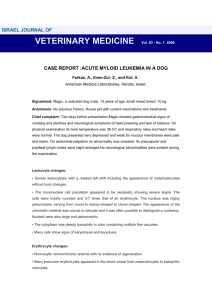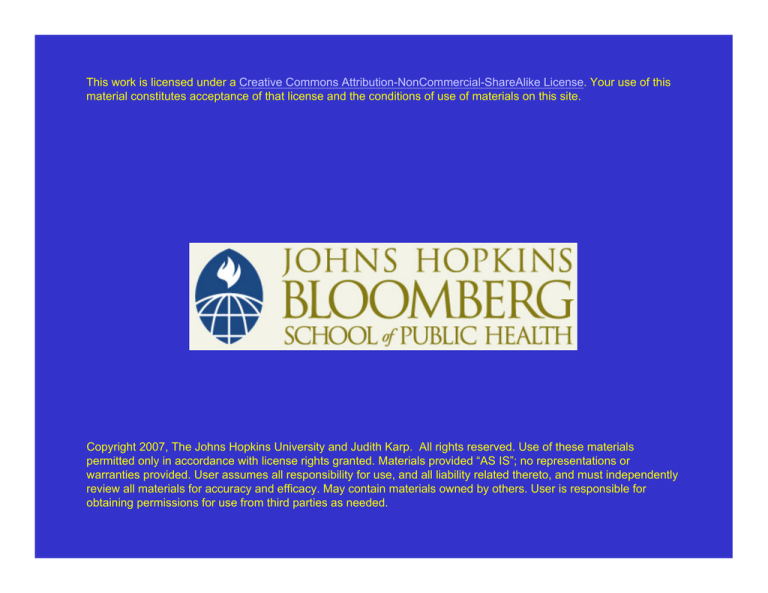
This work is licensed under a Creative Commons Attribution-NonCommercial-ShareAlike License. Your use of this
material constitutes acceptance of that license and the conditions of use of materials on this site.
Copyright 2007, The Johns Hopkins University and Judith Karp. All rights reserved. Use of these materials
permitted only in accordance with license rights granted. Materials provided “AS IS”; no representations or
warranties provided. User assumes all responsibility for use, and all liability related thereto, and must independently
review all materials for accuracy and efficacy. May contain materials owned by others. User is responsible for
obtaining permissions for use from third parties as needed.
Hierarchy Model of Hematopoiesis and
Leukemogenesis
CD33 +
CD33 -
AML
Leukemia Stem Cell
CD33 +
CD33 -
(Erythrocytes)
(Granulocytes)
HSC
Myeloid Stem Cell
(Platelets)
PATHOPHYSIOLOGY OF ACUTE LEUKEMIA:
DETERMINANTS OF CLINICAL PRESENTATION
Factor
Bone Marrow
Failure
Leukemia
Phenotype
Clinical
Consequences
Anemia
Bleeding
Infection
Correction
Restore Normal
Hematopoiesis
Leukostasis
Cytoreduction
Endothelial Damage
DIC
Extramedullary Tissue Infiltration
Tumor Lysis Syndrome
LEUKEMIA BIOLOGY:
A SIMPLISTIC VIEW
TWO MAJOR DEFECTS:
– INABILITY TO DIFFERENTIATE
– INABILITY TO DIE IN RESPONSE TO STRESS
Biological Advances:
Understanding Cellular Mechanisms →
Cancer
Tumor and Host Microenvironment:
Growth Factors, Motility Factors,
Angiogenic Factors
AML demographics 2006
• New cases = 12,000; deaths = 9,000
• Median age = 68 yrs
• Incidence = 3.8 per 100,000
• <65 yrs = 2.1 per 100,000
• > 65 yrs = 18 per 100,000
• Chance of developing AML
• For a 50 yr old = 1 in 50,000
• For a 70 yr old = 1 in 5,000
AML: Much work to do
Age
CR
DFS
Early
Death
<60
70%
45%
10%
>60
45%
20%
25%
OS
(median)
30%
(24 mo)
10%
(10 mo)
Based on CALGB, MRC trials in which adults of all ages were eligible
Slide kindly provided by Dr. Richard Stone
Why is AML in the older adult so
difficult to treat?
Disease Biology
• DNA Damage/Toxin Exposure Increases
with Age
• Detoxifying Enzyme Activity Decreases
with Age
• Immune Surveillance Decreases with Age
Host Biology
• Intolerance for Cytotoxic Chemotherapy
DNA REPAIR PATHWAYS
IDENTIFYING CRITICAL GENES IN
THE PROCESS OF
LEUKEMOGENESIS
Repairing DNA Damage: Lessons Learned
from Familial Cancer Syndromes
Selected Familial Leukemia-Prone Syndromes:
Lesions in Genes Responsible for Repairing DNA
Damage
• Fanconi Anemia (Repair of interstrand DNA
crosslinks)
• Xeroderma Pigmentosum (Nucleotide excision
repair)
• Bloom Syndrome (RecQ Helicase)
• Ataxia Telangiectasia
• Li-Fraumeni (p53)
Polymorphisms in DNA Repair Genes May
Determine Risk, Response, and Toxicity
• XPD Lys751Gln polymorphism Æ increased risk
of developing AML with -5q and/or -7q
• ERCC1 8092 C>A polymorphism Æ increased risk
for childhood ALL in males
• XPD Gln751/Asp312G haplotype Æ increased CR
for adults with AML >age 55
• ERCC1 polymorphisms Æ lung and metabolic tox
• XRCC3 241Met polymorphism Æ decreased risk
for liver toxicity
Fanconi Anemia Proteins: A “Master”
Switchboard for Repairing of DNA Damage
All 11 FA proteins cooperate in a pathway to:
• Recognize and repair DNA damage due to DNA
crosslinking agents (alkylators, platins,
mitomycin C)
• Coordinate with other DNA repair proteins (ATM,
ATR, Bloom, BRCAs!!) to form complexes that
localize to and repair damaged sites
FA Genes as Targets for Inactivation in
AML (Kennedy and D’Andrea, JCO, 2006)
Inherited biallelic inactivating mutations Æ high
incidence (~ 30%) of developing cancer by age
40, especially AML with adverse cytogenetics (-7,
abnormalities of chromosomes 1 q and 3q)
Heterozygous Carriers Æ high incidence of
breast/ovarian, pancreatic (esp. FANCD1/BRCA2),
low incidence of AML (FANCA missense
mutations)
Somatic inactivation of FANC genes in AML:
Deletions/mutations: FANCA, FANCD1, FANCG
Methylation: FANCA, FANCC, FANCF, FANCG
GENES AND ENVIRONMENT:
A LEUKEMOGENIC COMBINATION
AML: A Prototype
Environmental-Occupational Malignancy
Etiologic
Factors
% AML
Env/Occ Exposure
~30-35%
Benzene, Petroleum,
Organic solvents,
Arsenical Pesticides, Radiation
Therapeutic Agents ~20%
DNA Damaging Agents
Topo-II Directed Drugs
Genetic
Abnormalities
-5/5q, -7/7q, 3q26
t(8;21), +8, +21
-5/5q, -7/7q, 3q26
AML-1 mutation (21q22)
Translocations (11q23)
Benzene: The Classical
Environmental Hematotoxin
• 1930’s: 1st association between benzene
and bone marrow disorders
• 1950’s: Direct link between chronic
exposure and acute leukemia
demonstrated in long-term study from
Turkey when benzene-based adhesives
were first used (Askoy 1972)
• 1970’s: Large-scale NCI cohort study in
China beginning 1972 Æ dose-dependent
incidence of MDS/AML <10 ppm Æ RR 3.2,
>25ppm Æ RR 7.1 (Hayes 1997)
Selected Mechanisms of
Benzene Hematotoxicity
• Intermediary benzene metabolites Æ direct DNA
damage Æ activate p53 and, in turn, p21 Æ cell
cycle arrest (Yoon, Exp Hematol 2001)
• Hydroquinone causes selective deletion of
chromosome 7 (by FISH) in CD34+ marrow cells
(Stillman, Exp Hematol, 2000)
• Low level airborne exposure to benzene (gas
station attendants, police) Æ altered methylation
of p15 (↑) and MAGE ↓) (Bokati, Ca REs 2007)
NAD(PH): QUINONE
OXIDOREDUCTASE (NQO1)
• NQO1 gene located on chromosome
16q23
• Induced by antioxidants Æ protects
against oxidative stress
• Inactivated by 609C Æ T polymorphism
Intersection of Benzene and 609C Æ T
NQ01 Polymorphism
• NQO1 detoxifies marrow-genotoxic benzene
metabolites (phenols, benzoquinones) to less
toxic hydroxyquinone metabolites
• Inactivating 609CÆT associated with >7-fold
increased RR for benzene poisoning
(Rothman,Ca Res, 1997)
• Low exposure (<1ppm) Æ decrease in WBC,
platelets, colony-forming progenitors; most
toxicity in 609CÆT NQO1 and/or fully active MPO
(converts benzene to toxic quinones) (Lan,
Science, 2004)
More Evidence Tying 609CÆT to
Increased Risk of Leukemia
• ↑ frequency low or null NQO1 activity in all
acute leukemias: for de novo leukemias,
highest frequency seen in de novo AML
with inv(16) (Smith, Blood 2001)
• ↑ prevalence in AMLs with -5/-7 and TAML, with greatest prevalence in
homozygotes (Larson, Blood 1999)
• ↑ risk 11q23 (MLL gene)-rearranged infant
ALL (Smith, Blood 2002) or infant ALL
without MLL rearrangements (Lanciotti,
Leukemia 2005)
GLUTATHIONE S-TRANSFERASES
(GSTs)
• Family of isoenzymes (α,μ,ρ,Θ) that detoxifies
anthracyclines and epipodophyllotoxins (VP16):
induced by oxidative stress (DNA and lipid
damage by reactive oxygen species)
• Null polymorphisms are common for each
subfamily
• Epidemiologic relationships between “null” μ or
Θ genotypes and increased risk for developing
CLL and MDS – relationships with genesis of
treatment-related AML and de novo childhood
ALL not so clear
GST Polymorphisms May Relate to
Chemotherapy Drug Metabolism and Clinical
Outcome
•
•
•
•
Homozygous deletions in GSTM1 and/or T1 Æ drug
resistance and short overall survival in AML (Voso, Blood
2002) but not in childhood ALL (Davies, Blood 2002)
High blast glutathione levels Æ ↑ risk of relapse in
childhood ALL (Kearns, Blood 2001)
Null GST-T1 genotype Æ increased early death (toxicity) in
AML (Naoe, Leukemia 2002)
SWOG multiple AML therapies Æ no clear impact of GST
polymorphisms on toxicity, early mortality achievement or
duration of remission (Weiss, Leukemia 2006)
Treatment-Related AML After
Treatment for Breast Cancer
• 1970’s: Case reports of women < age 60 who
received chemo but no XRT Æ AML (Davis,
Cancer 1972)
• 1980’s: AML RR post-breast cancer therapy: 2.4
local XRT alone, 10 alkylators alone; 17.4
alkylators + XRT (Curtis, NEJM 1992)
• 1990’s: ↑AML risk with DNA intercalators
Epirubicin (+ alkylators: Pederson-Bjerrgaard,
JCO 1992; Praga, JCO 2005) and Mitoxantrone (+
XRT: Carli, Leukemia 2000; Chaplain JCO, 2000) –
risks are dose-dependent
• 1990’s (NSABP trials): AML risk relates to CY
dose (in CY/Adr combo), XRT, and use of G-CSF
BREAST CANCER AND AML:
A “LOCAL” PERSPECTIVE
• Among 230 women ages 18-86, 33 (14.3%) have a
history of breast cancer and an additional 47
(20.3%) have positive family history (mainly
breast/ovarian, also heme and/or multiple ca’s)
• Of the 33 women with AML and Hx breast cancer:
– 19 (58%) < 60 at breast ca Dx (med 51, range
36-76)
– 20 (61%) did not have chemotherapy:
• 8 Æ no chemo or XRT, 12 Æ XRT only
• 4 Æ chemo only, 9 Æ chemo + XRT
Therapy-Related AML: Could We
Predict Who Is At Risk?
Development of T-AML appears to be increased in
patients with:
• Defective expression of mismatch repair proteins
Æ microsatellite instability (Ben-Yehuda, Blood
1996; Zhu, Blood 1999; Rund, Leukemia 2005)
• Variant polymorphisms in HLX1 (homeobox gene)
and Rad51 (DNA repair) (Kawad, Blood 2006)
In contrast, the CYP3A4 1*B genotype may confer
protective effect against T-AML (Rund, Leukemia
2005)
CLINICAL TRIALS:
THE ROAD TO MEDICAL ADVANCES
Clinical trials are important because:
•
At the present time, we don’t have a reasonable “standard
of care” because we are not curing nearly enough people
•
Clinical trials with new ideas and new drugs the offer a
chance to do better
– What we have learned from clinical trials in years past is
the basis for what we do today (and we are better than
we were 2-3 decades ago!)
•
What we learn from today’s trials will help us to develop
more effective approaches tomorrow
TYPES OF CLINICAL TRIALS
• Risk Assessment Æ Prevention
• Early Detection and Diagnosis
• Treatment
– Primary Disease
– “Secondary Prevention” (Adjuvant Therapy,
Minimal Residual Disease/Maintenance)
– Recurrent/Refractory/Metastatic Disease
• Quality of Life
– Quantity vs. Quality – how can we measure
that?
– What is the cost to the person and to society?
“Secondary” Leukemia Research
Agenda: Molecular Epidemiology
Define pathways/processes leading to loss of cell cycle
regulation, inappropriate cell survival and net genomic
instability
– Genetic Susceptibility (Host response to Toxins and
DNA Damage)
• DNA Repair Genes and Pathways
• Pharmacogenomics (Intracellular toxin metabolism)
– “Epigenetic” Factors
• DNA damageÆ altered gene expression through
methylation and/or histone deacetylation
“Secondary” Leukemia Research
Agenda: Clinical Epidemiology
• Define populations at risk for
leukemogenesis: A folie a deux between
genetics and environment
– Longitudinal studies to quantitate dose-risk
relationships for leukemogenic agents
– Serial monitoring of “at risk” populations to
identify “leukemia intitiation”
“Secondary” Leukemias:
Clinical Interventions
• Prevention for patients at high risk
– Screening for predisposition Æ intervene
before cumulative genetic damage ensues:
Vaccines????
– Avoid specific agents in patients with
susceptibility to certain types of DNA damage
• Innovative treatment approaches
– Epigenetic modulation
– Overcome pro-survival pathways
– Inhibit DNA repair pathways
CHALLENGES TO TRANSLATIONAL
CLINICAL RESEARCH :
Common Misconceptions
Patient samples grow on trees
Man is related to any/all:
1. Mouse 2. Cell line 3. Nude mouse 4. Agar colony
Isolated cells are just like cells in their natural habitat
Patients, like inbred mice, are all the same
Insurance companies really have the patient’s interest at heart
IRBs protect all of us from the bad, mad doctors who just want
to “spearmint” on those poor, unsuspecting patients
The FDA makes thoughtful decisions about drug safety and
efficacy
Why should clinical research cost anything? After all, the
patients are already there
A MAJOR CHALLENGE FOR ALL
AREAS OF MEDICINE
How do we get the best medicine *to
EVERYONE, not just those who can pay or
be paid for??
*What is the best medicine? In the setting of
inadequate cure rates, it is a clinical trial that
offers the possibility of doing better!

